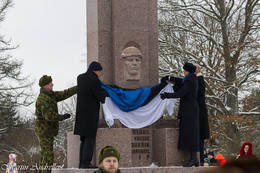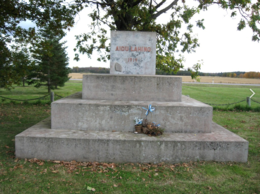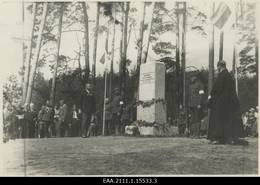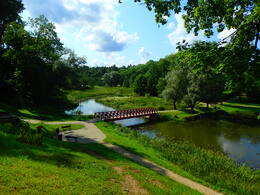Breakthroughs of the War of Independence: this far and no further
I Wars of Independence
The decisive battles of the War of Independence took place in January and February 1919, forcing the Red Army to retreat from Estonia.
On 28 November 1918, Soviet Russia launched its offensive on Estonia starting the War of Independence. The Red Army advanced quickly in Estonia throughout December. One by one the towns of Jõhvi, Kunda, Rakvere, Tapa and Aegviidu in North Estonia and Võru, Valga, Tartu, Tõrva and Mõisaküla in South Estonia fell under the control of the Bolshevists. By January 1919, the Red Army was just 40 km from Tallinn.
After nearly two months of retreating, the Estonian army gathered its strength to fight back. In December 1918, the supreme command of the armed forces were preoccupied with organising the army. They carried out mass conscription and sent new units to the battlefront. The arrival of a British Royal Navy squadron and Finnish volunteers in Tallinn helped turn the tide in the war against the Soviets. The reassurance from having allies against Soviet Russia boosted morale among soldiers and civilians. The turning points which took place in early January 1919 stopped the Soviet advance with Estonians taking the initiative.
By 5 January 1919, 14,000 men had been mobilised and the Estonian forces had launched their counter-offensive. On 19 January, the town of Narva was liberated, pushing the front line back along Narva River. On 14 January 1919, the joint forces of broad-gauge armoured trains and the partisan regiment led by Lieutenant Kuperjanov liberated the town of Tartu. The town of Valga was liberated in the deadly Battle of Paju on 1 February, followed by the liberation of Võru on 3 February. 1. Marine troops on the coast of the Finnish Gulf led by Counter Admiral Johan Pitka instilled panic in Red Army troops in the rear.
On 24 February 1919, one year after the Estonian declaration of independence, Commander-in-Chief of the Estonian Armed Forces General Johan Laidoner reported to the Estonian Provincial Assembly that the enemy has been pushed behind Estonian borders. Estonia was liberated in less than two months.
Related objects
Kehra Museum – Kehra Station NGO
This private museum, which opened in 2018, is located in an historic late-19th-century railway station.
Its exhibition showcases the decisive battles of the War of Independence fought near Kehra in early 1919. The station itself served as military headquarters in the early days of 1919, with armoured trains stationed here and the series of battles that launched the Estonian advance to victory being led from here.
Monument to Kehra battle
The Battle of Kehra, which was fought on 4 January 1919, was the first successful armoured train offensive and the turning point in the War of Independence, halting the Soviet advance on Tallinn. Legend has it that General Laidoner, on arriving at the site, personally demanded that the battleground be marked out. This monument was the last to be completed before World War II. It was never officially unveiled – the inauguration which was planned to be held on 23 June 1940 was cancelled due to the invasion of the Soviet forces. The 6.5-metre monument was blown up in late 1944 (although some sources state that this took place as early as 1940) and its stone blocks were used for the construction of nearby summer houses. The railway stop near the monument, which was named Lahinguvälja (Battleground) during the independence era, was renamed Vikipalu in 1957 by the Soviet regime. Following the restoration of independence, the stop was granted its original name. The monument was restored in a smaller form using the remaining parts of the original and was unveiled on 23 June 2000. Restored in its original form, it unveiled anew on 6 January 2019 as part of the centenary celebrations of the Republic of Estonia. The column is adorned with the relief of a soldier's face and reads: "Here the enemy offensive was halted and thus began our forces' march to victory on 4 January 1919".
Altar of Victory in Aidu
The Altar of Victory is situated next to the former dairy on Vaadu Farm in Aidu, by the Jõgeva-Põltsamaa road.
It is a monument to the War of Independence. This monument marks the furthest point a Red Army soldier advanced.
The monument designed by Eduard Järve was unveiled on 23 June 1929. In 1932 two oak trees were planted near the monument, one of which has survived. On 4 January 1934 the 2nd Infantry Battalion replanted an oak tree brought from Aidu on the square at Lembitu barracks in Tartu in honour of the battle of Aidu.
On 4 January 1934, the 2nd Infantry Battalion uprooted one of the oak trees in Aidu and replanted it on the square in front of the Lembitu barracks in Tartu in memory of the Battle of Aidu. The monument was blown to pieces in 1940 before being completely destroyed in 1965. The current copy of the original monument was unveiled on 23 June 1989.
Monument to the Battle of Reola
This monument is situated in the village of Tõõraste in Kastre municipality. Designed by Anton Sobolev, it commemorates the Battle of Reola, which was one of the turning points in the War of Independence. During the battle, which took place on 16 & 17 January 1919, the Estonian forces thwarted the Red Army’s attempt to capture Tartu. The monument was unveiled on 3 July 1932. After World War II it was knocked down and buried. On 27 November 1988, the monument, now dug up and restored by the Kambja Heritage Association, was unveiled anew.
Misiņkalns Military Heritage Trail
Misiņkalns nature park is located in the town of Aizpute. Misiņkalns is the highest place in the city of Aizpute. Its height reaches 95.4 m. The top offers a scenic view of the city. Misiņkalns nature park was started to be built in the 20th century. at first. The area of the park is currently about 28 ha.
In the territory of the park there are several places and memorials related to the events of the 20th century - the memorial stele of the soldiers who died in the Latvian Freedom Wars - the cavaliers of the Lāčpleš Order, the place of the Holocaust memorial, the place of remembrance of the repressed and the memorial plaque of the fallen red partisans.
In the park, you can get to know the plants and plantations of various rare species, as well as enjoy the untouched nature. Currently, the park is criss-crossed by renovated walking and cycling paths, and there is a motorcycle track on the territory of the park, where Latvian motocross competitions take place.
In order to get to know the cultural and historical heritage of Misiņkalns manor park more fully, we recommend using the services of a guide.
Related stories
Aizporis Manor during the War of Independence
Aizporu Half Manor, Aizpute district, Kalvene municipality, is the westernmost place in Latvia to which Colonel Oskars Kalpaks' separate battalion retreated.
Halfway between Rudbārži and Kalvenė, on the side of the road, is the Aizpore cemetery. There is a monument and 12 memorials to the volunteer soldiers of Oskars Kalpaka's battalion.









